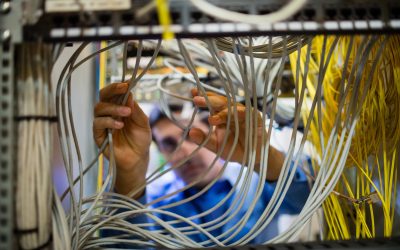Designing and Managing Network Infrastructure

Tags: news
This Blog focuses on designing buildings, building systems and building products that have the capacity to absorb networks, and above all, to accommodate change.
Structured cabling has become an accepted way of dealing with the proliferation of interlinked electronic devices; very few building developers today would dream of specifying a new office without adequate vertical ducts, generous floor to ceiling heights, or access floors; simpler design strategies for rehabilitating difficult older buildings are becoming routine. Office furniture manufacturers comprehend how important their products are for making networks work. Ways are being found to achieve simpler and cheaper – and less volume consuming – architectural solutions to manifold problems associated with accommodating networks. Best of all, it is now far more common for clients, IT specialists, facilities managers, and all the many and varied members of building design teams, to communicate with each other, using the same language and the same concepts, during the design of even the most immense and complex office buildings.
Was introducing networks into buildings no more than a troubled dream? Can design teams now relax and get back to old and often lazy ways? Can old designs and specifications be dusted off? The answer, for three very important reasons, is quite simply, ‘No’.
First, the process of the diffusion of networks throughout all organizations is still not or ever will be complete. Wherever, whenever and however networks are used, there will always be trouble and change. Second, all organizations are increasingly dependent on the network – addicted one might say – and quite literally, cannot live without it. The correct infrastructure is essential for organizational survival. The relationship between the network and building design is simply far too important to the survival of too many organizations ever to be forgotten or ignored. Third, the network, important as it is as a technical phenomena, is much much more important as the solvent of traditional social and organizational conventions that have held businesses and cities together for well over a century. After the network, nothing about office work – neither location, nor commuting, nor the mix and type of staff, nor the conventional shape and specification of office buildings, nor building services, nor the choice of furniture, nor the unique ownership of individual workstations, nor the importance (or unimportance) of meetings, nor the design of equipment, nor the greatest and most limiting conventions of all, the nine-to-five working day – can ever be taken for granted again.
Modern organizations have become dependent on the use of the network. It has fundamentally changed the way in which basic office work, such as production, distribution and storage of documents, is carried out. All parties involved in the design and development of office complexes must accommodate network requirements at early stages in office planning.
Planning offices in a changing environment
Networks have caused fundamental rethinking in office design, because of the impact that it has on people and their work, and because of the accommodation demands made by network equipment on office space, lighting and power. Probably the most certain feature of the network in the office is uncertainty. No wonder architects and office planners have had such difficulty coming to terms with the issues. Although the acceleration of developments in networking is not set to decline, it is possible to prepare for future forms of technology and their impact of businesses in general, and upon offices in particular.
Accommodating the modern organization
Networking has already changed the way in which organizations are structured. These changes will certainly continue. They are changing the role of the office, increasing its significance as a meeting place and reducing its primary role of providing accommodation for office workers and their desks.
The changing ways in which people work define the organization of the future. Traditionally companies and public bodies were organized around such familiar principles as full-time employment, hierarchy, attendance at office buildings and standardization of terms and conditions. These are clearly under pressure.
The role of the building is evolving to suit new organizational structures. The traditional role of the office building is to accommodate people and their files. It has also provided a meeting place for customers, suppliers and consultants, as well as for the organization’s own staff. It has and is changing this gradually. Computers are increasingly automating the more routine business functions, reducing the need for clerks, typists and data entry staff. Computers also make it possible for an increasing proportion of the remaining staff to work away from the office, which becomes a communication center for the organization.
These changes have implications for the location and aesthetics of a building. There are other implications too. For instance, there is an increased emphasis on travel outside the usual rush hours. Furthermore, buildings need to provide more meeting rooms and a lower proportion of office space. Some of the office space needs to be allocated to staff on temporary rather than permanent basis.
The implication for the design of the network systems is that the staff should be able to access their requirements from anywhere in the building, via workstations or laptops with appropriate password access controls. The use of cordless phones and more and more intelligent switches also allows the same extension to be used wherever the staff are working.
Requirements and cost of ownership
Although the main trends in the deployment of networks are common to all organizations, no two organizations will implement them in exactly the same way. To the building designer, this means either that every project is a one-off, or that sufficient space must be provided to accommodate and service a wide range of both central and local computers and LANs. Installing sufficient capacity to meet initial needs for space, power and cooling services, plus planning sufficient infrastructural capacity to meet the growth and change in the longer term is a common solution. Although there will be an initial premium to pay for making these provisions against future requirements, savings are possible over the longer term, as it is possible to meet future requirements more efficiently.
The difficulty of predicting space and service requirements can be overcome by planning for adaptability. Because buildings are designed to last for decades rather than years, they will have to meet many changing requirements over their lives. In particular, many will need much higher levels of electrical power and cooling in the future than when they were built. Although providing, at the outset, all the facilities that could ever be required is obviously uneconomical, design teams too often consider only the immediate requirements.
The solution to the problem of balancing cost and premature obsolescence is for the design team to distinguish clearly between initial requirements and the capability, built into the infrastructure, to meet future requirements. The design team cannot attempt to design a building that meets all requirements, but rather one that can be adapted to meet them all. This adaptability is reflected in the design and sizing of spaces and in the services and infrastructure.
When planning the services infrastructure, the main fixed elements such as chilled water pipes, main electrical cable and vertical risers/conduits should be sized to meet the highest foreseeable requirements and should service the whole building.
Many organizations consider only the capital cost of a new building and the associated initial fit-out, without considering the longer term operational costs. This often precludes the organization from making significant savings in the running costs of the building. The use of a building management system to control the environment and turn off the lights in the evenings is an example of an ongoing cost reduction scheme requiring significant capital investment.
One of the major benefits of investing in a flexible building infrastructure becomes evident when it comes to re organizing the office layout. In a traditional office layout, it typically takes two or three months to plan and implement an office re organization, incurring significant costs and much out-of-hours working. However, with a flexible environment and infrastructure, an office re-organization may be planned and executed quickly and at very little cost. Therefore the cost of ownership of the building can be lower over time, even when the initial investment in the building infrastructure is higher. Buildings should be designed to minimize the cost of ownership, not initial capital outlay.
If you are interested in learning more, take a look at the Network Project Planning and Safety courses.

Written by James Donovan
You might also enjoy
FO Connector Contamination – A Constant Threat
Fiber optic communication most commonly works in duplex or multifiber transmission by transmitting light to a receiver in one direction on a fiber and receiving transmitted light back to a second receiver on the second fiber. Most engineers can understand that and...
Why Inspect and Clean Fiber Optic Connectors?
Inspecting and cleaning of fiber optic connectors during installation and when making any patching, is essential. Any contamination on a patch cord connector will be transferred through the coupler to the connector it is mated to. Even when testing fibers with a test...
Cleaning MPOs
MPO connectors should always be inspected with a scope before they are used, be that on a patch cord or a bulkhead. If they need to be cleaned, one-click cleaners are keyed to ensure the tip only fits one way onto the connectors and is able to clean both male and...


